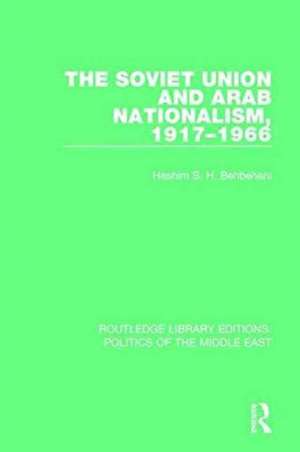The Soviet Union and Arab Nationalism, 1917-1966: Routledge Library Editions: Politics of the Middle East
Autor Hashim S.H. Behbehanien Limba Engleză Paperback – 12 dec 2016
| Toate formatele și edițiile | Preț | Express |
|---|---|---|
| Paperback (1) | 320.36 lei 6-8 săpt. | |
| Taylor & Francis – 12 dec 2016 | 320.36 lei 6-8 săpt. | |
| Hardback (1) | 672.40 lei 6-8 săpt. | |
| Taylor & Francis – 20 iul 2015 | 672.40 lei 6-8 săpt. |
Din seria Routledge Library Editions: Politics of the Middle East
- 12%
 Preț: 330.57 lei
Preț: 330.57 lei - 13%
 Preț: 323.44 lei
Preț: 323.44 lei - 12%
 Preț: 327.58 lei
Preț: 327.58 lei -
 Preț: 303.92 lei
Preț: 303.92 lei - 12%
 Preț: 327.58 lei
Preț: 327.58 lei - 14%
 Preț: 325.34 lei
Preț: 325.34 lei - 13%
 Preț: 297.62 lei
Preț: 297.62 lei - 13%
 Preț: 295.10 lei
Preț: 295.10 lei - 14%
 Preț: 300.01 lei
Preț: 300.01 lei - 13%
 Preț: 322.51 lei
Preț: 322.51 lei - 13%
 Preț: 297.15 lei
Preț: 297.15 lei - 12%
 Preț: 325.34 lei
Preț: 325.34 lei - 12%
 Preț: 325.34 lei
Preț: 325.34 lei -
 Preț: 457.14 lei
Preț: 457.14 lei -
 Preț: 310.67 lei
Preț: 310.67 lei - 12%
 Preț: 329.14 lei
Preț: 329.14 lei - 12%
 Preț: 325.84 lei
Preț: 325.84 lei - 14%
 Preț: 299.52 lei
Preț: 299.52 lei - 12%
 Preț: 329.26 lei
Preț: 329.26 lei - 12%
 Preț: 326.29 lei
Preț: 326.29 lei -
 Preț: 284.52 lei
Preț: 284.52 lei
Preț: 320.36 lei
Nou
Puncte Express: 481
Preț estimativ în valută:
61.30€ • 64.17$ • 50.72£
61.30€ • 64.17$ • 50.72£
Carte tipărită la comandă
Livrare economică 05-19 aprilie
Preluare comenzi: 021 569.72.76
Specificații
ISBN-13: 9781138925519
ISBN-10: 1138925519
Pagini: 262
Dimensiuni: 156 x 234 x 15 mm
Greutate: 0.39 kg
Ediția:1
Editura: Taylor & Francis
Colecția Routledge
Seria Routledge Library Editions: Politics of the Middle East
Locul publicării:Oxford, United Kingdom
ISBN-10: 1138925519
Pagini: 262
Dimensiuni: 156 x 234 x 15 mm
Greutate: 0.39 kg
Ediția:1
Editura: Taylor & Francis
Colecția Routledge
Seria Routledge Library Editions: Politics of the Middle East
Locul publicării:Oxford, United Kingdom
Public țintă
Postgraduate and UndergraduateCuprins
1. China and the Arab World 1.1. The Bandung Conference and its Aftermath 1.2. Radicalisation of China’s Foreign Policy 1.3. The Contradictions of China’s Three Worlds Theory 1971-5 2. Sino-Palestinian Relations 1955-66 2.1. The Initial Phase: 1955-63 2.2. First Direct Sino-Palestinian Contacts: 1964-5 2.3. The Creation of the PLO and its Relations with China 3. The 1967 June War and its Aftermath: Developments in the Palestine Resistance Movement 3.1. China’s Attitudes and Involvement in the Arab-Israeli Conflict 1967-9 4. Black September and its Aftermath 4.1. Sino-Soviet Rivalry in Sino-Palestinian Relations 4.2. Black September and China’s Involvement In It 4.3. China and the ‘Political Settlement’ Solution 4.4. China’s Admission to the United Nations 5. Turning Point in Sino-Palestinian Relations 5.1. The Expulsion of the Soviets from Egypt Results in the Deterioration of Sino-Fatah Relations 5.2. The October War and China’s Positions 5.3. The Turning Point 6. Brief History of the Liberation Movement in Oman 6.1. Rise of the Nationalist Movement 6.2. Changing Trends in the Gulf 6.3. Development of the Nationalist Struggle in the 1970s 7. China’s Attitudes To, Involvement In, and Withdrawal From, the Omani War, 1955-75 8. China and Kuwait 8.1. Sino-Iraqi Relations 8.2. Kuwait’s Independence and Conflict with Iraq 8.3. Kuwait’s Relations with China Before Recognition 8.4. China and Iran 8.5. China Tries to Use Kuwait as a Stepping Stone in its Relations with the Gulf 8.6. The October 1973 War and China’s Attitude Towards Arab Oil Policy 8.7. Sino-Kuwait Relations in 1974-5: Sports Diplomacy. Conclusion. Appendix 1. Fatah Military Study on China Appendix 2. Arab Labour Party of Oman’s Study on the Historical Development of Oman Appendix 3. PFLOAG: Internal Directives Appendix 4. Minutes of Talks Appendix 5. Sino-Arab Delegation Exchanges, 1956-75 Appendix 6. Sino-Arab Trade, Cultural and Friendship Treaties and Agreements, 1955-75
Descriere
China’s foreign policy in the Arab world is important because it reflects China’s general foreign policy. In this study, first published in 1981, the author draws upon a wealth of previously unpublished and inaccessible material to analyse Chinese attitudes in three cases: the two Arab liberation movements, the Palestine Resistance Movement and the Popular Front for the Liberation of the Oman, and the established and independent State of Kuwait. Since the Arab liberation movements played a significant political role within their fields of operation, it was necessary for China to decide whether these movements did actually fit in with Chinese foreign policy objectives. Dr Behbehani’s analysis of these two case studies provides the basis for a discussion of whether China’s motives in supporting the liberation movements are theoretical or purely practical. China’s support for Kuwait’s political internal continuity is related to the stability of the whole Gulf region. The author analyses Chinese support for Kuwait and the surrounding conservative states on two main bases, political and economic, in the form of trade. It is through these channels, particularly the economic one, that China has sought to establish itself in the Gulf and the Arabian peninsula.
